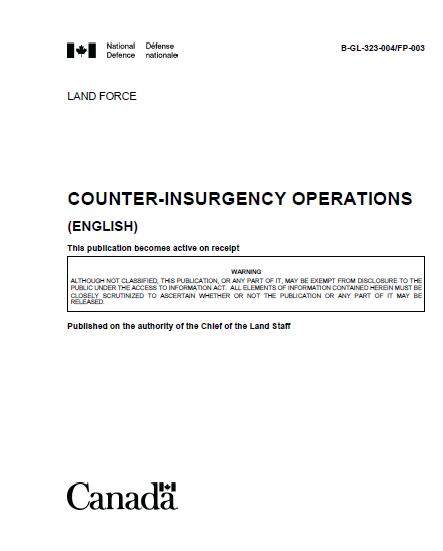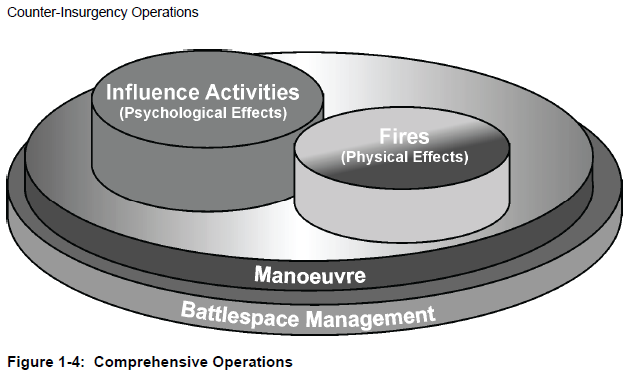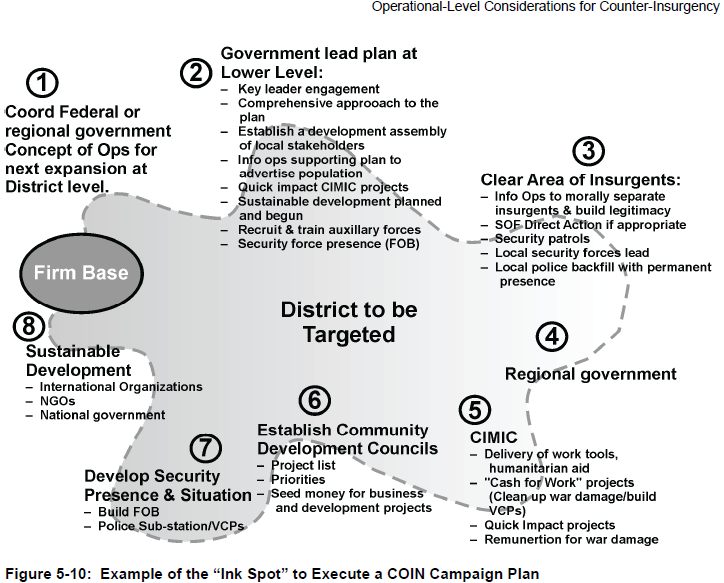 B-GL-323-004/FP-003
B-GL-323-004/FP-003
- 249 pages
- ALTHOUGH NOT CLASSIFIED, THIS PUBLICATION, OR ANY PART OF IT, MAY BE EXEMPT FROM DISCLOSURE TO THE
PUBLIC UNDER THE ACCESS TO INFORMATION ACT. ALL ELEMENTS OF INFORMATION CONTAINED HEREIN MUST BE
CLOSELY SCRUTINIZED TO ASCERTAIN WHETHER OR NOT THE PUBLICATION OR ANY PART OF IT MAY BE
RELEASED. - December 13, 2008
103. COUNTER-INSURGENCY
1. Counter-insurgency is defined as follows:
Those military, paramilitary, political, economic, psychological and civic actions taken to
defeat an insurgency.2. Since an insurgency is a political problem, the military plays a largely supporting role to
other agencies and government departments in countering an insurgency. As indicated in the
definition, a wide range of agencies, elements of power and capabilities, in addition to the
military, must come together in a unity of purpose to defeat an insurgency.3. A COIN campaign is conducted through a specific philosophy and a set of specific
principles that guide the application of combat power. It is distinctly different from the conduct of
an insurgency itself, and the lines of operation within the COIN campaign must counter the lines
of operation of the insurgents. Within the guiding principles, each COIN campaign must be a
custom approach to the insurgency at hand. The constant is the fact that insurgency and
counter-insurgency are essentially about the battle to win and hold popular support both at
home and in the theatre of operations. If the strategic focal point is public opinion in the local,
domestic and international arenas, most initial military tactical efforts will be focused on breaking
the link between the insurgent and the people. This is not only a physical link, but the
psychological link of moral support. The former will entail physical activities, whilst the latter will
entail influence activities that undermine and attack the insurgent ideology, narrative and claims
to authority and legitimacy. This will include measures to address and resolve grievances that
lend support and credibility to the insurgency. If the insurgent can be isolated, it is then
theoretically a relatively simple matter to eliminate him and his cause.4. In order to reach this point, a COIN campaign will involve more than military
engagement. Defeating an insurgency requires not only the neutralization of insurgent military
capabilities but also the resolution of the root causes of the political and socioeconomic
grievances that enabled its occurrence in the first instance. Therefore, it requires a
comprehensive approach, with multiple agencies and other government departments, often
enabled through a coalition effort. The mere attrition of insurgents is highly unlikely to result in
the defeat of the insurgency. Indeed, any attempt to win an insurgency through attrition may
only help fuel that insurgency. Only a comprehensive approach that addresses the root causes
of an insurgency and attacks the legitimacy and authority of the insurgents will obtain an
enduring solution.…
…
210. BASIC TENETS OF AN INSURGENCY
1. All successful insurgents adhere to certain basic tenets. Naturally, such principles must
be applied rationally within the existing social and political circumstances when assessing an
insurgency. These tenets are:a. a suitable cause;
b. leadership;
c. popular support;
d. organization and actors; and
e. a narrative.211. MOTIVATING CENTRAL CAUSE
1. In most insurgencies there will be legitimate grievances that may result in a central,
motivating cause to the insurgency or may be exploited by the insurgent leaders so that a lack
of grievance resolution supports the cited cause. As mentioned previously, the definition of “the
cause” is crucial as a rallying point. The cause must appeal to all levels, from supporting the
philosophic ideals of the strategic leadership to the tactical motivation of the rank and file. The
cause is articulated in the motivating idea and resulting narrative (see below). The sooner that
legitimate grievances are addressed by the authorities, the better will be the ability to influence
the populace to not support the insurgency.…
6. The Tactic of Terrorism. Terrorism is a tactic. Despite the attention that it receives,
terrorism is a tactical level undertaking; however, one that is normally used to influence the
situation at the operational and strategic levels. It may be used by individuals, groups or states
as part of a larger operational objective and strategy to intimidate and coerce governments,
societies or elements of each. Terrorist actions call attention to the perpetrators and their
causes and may help them win support of potential sympathizers. Terrorism is used to strike at
civilian targets which normally have limited means of self-defence. The more spectacular or
outrageous the action, the louder it speaks. Terrorist attacks seek to undermine the legitimacy
of the indigenous government and security forces by demonstrating their inability to counter the
threat and prevent attacks. Thus, the key effect of terrorist attacks is psychological, in that they
seek to shape the perceptions of various audiences, locally, regionally and internationally. The
physical damages caused are simply the means of sending their message. Through the
resulting psychological impact, terrorist attacks seek to force policy changes or specific actions
by the effected governments. For example, at a tactical and operational level, they may seek to
cause an over-reaction by local security forces, thereby giving testimony to claims of
discrimination and bias against the perpetrating group. At the operational and strategic levels
they may seek to force a nation to withdraw its forces from a coalition campaign. Terror tactics
may include assassinations, bombings, hostage-takings, kidnappings, hijackings and sabotage.
The method chosen will try to exploit a perceived weakness within the adversary or to attack
what was thought to be a strength in order to heighten the psychological effect. Terror tactics
evolve with new technology and the availability of weapon systems, and seek to exploit
globalization, often through international criminal organizations. The speed of global
communications has supported and enhanced the messages that the perpetrators send through
their use of terror. These changes have served to strengthen the traditional network-based cell
structures favoured by organizations that use terror. This in turn reduces the efficacy of certain
traditional countermeasures, such as leadership targeting, and makes penetration more difficult.
In short, recent developments in the nature of global communications have made terror a
cheaper and more effective tool than in the past.…


